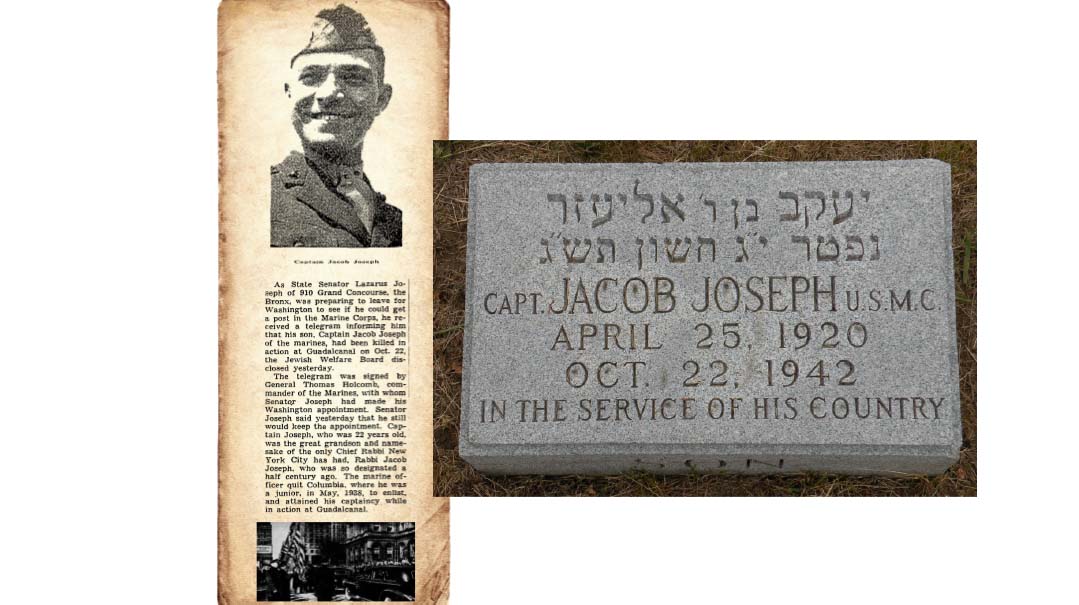Captain Jacob Joseph: Rabbinic Scion, American Hero
| October 12, 2021Following the death of his son, Lazarus Joseph initiated the first regular minyan in the State Capitol building in Albany to recite Kaddish

Title: Captain Jacob Joseph: Rabbinic Scion, American Hero
Location: Lower East Side
Document: New York Times
Time: 1942
Not far from the original site of the Jacob Joseph School, on the corner of Henry and Rutgers streets in Manhattan’s Lower East Side, stands the iconic Captain Jacob Joseph Playground. Dedicated by leading city officials in 1947, it’s named for a 22-year-old US Marine who was killed in a bloody World War II campaign on the Pacific island of Guadalcanal five years prior.
Following the decisive defeat of the Imperial Japanese Navy at the Battle of Midway in June 1942, the Guadalcanal campaign in the Solomon Islands, waged between August 1942 and February 1943, was a prolonged battle that ultimately ended in a strategic Allied victory, with the US Navy now able to take the offensive, in contrast to its defensive posture following Pearl Harbor. Allied naval forces under Admiral William Halsey engaged the Japanese under Admiral Isoroku Yamamoto, with dozens of ships and thousands of combatants finding their end in the vast sea graveyard known as “Iron Bottom Sound.”
United States Marine and Army detachments battled the Japanese on land for control of the island and its airfields. The enormous loss of life prompted Japan’s Major General Kiyotake Kawaguchi to remark, “Guadalcanal is no longer merely a name of an island in Japanese military history. It is the name of the graveyard of the Japanese Army.”
Of the approximately 550,000 American Jews who served in the US armed forces during World War II, many lost their lives in the Pacific theater. Among those was Captain Jacob Joseph, who left the Grand Concourse in the Bronx to enlist in the Marine Corps.
The death of Captain Jacob Joseph made headlines, and it wasn’t just due to his status as the youngest captain in the US Marines. He was the great-grandson and namesake of Rav Yaakov Yosef, the Rav Hakollel who had served as New York’s first and only chief rabbi a half-century prior and likewise died prematurely amid tragic circumstances.
In addition to being a descendant of Rav Yaakov Yosef and his son, Jacob Joseph School co-founder Rabbi Raphael Joseph, the deceased was the son of famed lawyer and politician Lazarus Joseph. A dedicated civil servant who served several terms in the New York state senate, he was elected in 1945 as the first Orthodox Jew to serve as New York City’s comptroller. Among the many Jewish institutions and organizations assisted by Lazarus Joseph was the refugee Mir Yeshivah, whom he helped resettle in government housing in New York City following their arrival from Shanghai in 1946.
Capital Kaddish
Following the death of his son, Lazarus Joseph initiated the first regular minyan in the State Capitol building in Albany to recite Kaddish. The minyan was put on hold for two decades until New York State Assembly Majority Leader Moses M. Weinstein revitalized it in 1967 following the passing of his father. It often had a crowd of nearly 30 participants as Albany’s Jewish contingent had significantly grown in the interim. Ironically, Weinstein also has a playground named for him, in the heavily Jewish neighborhood of Kew Gardens.
Hebrew Hammers
While there were many Jewish Marines who fought on Guadalcanal, two who stand out are the Schweibish brothers, Private Jack and Sergeant Albert of Chicago, both of whom received Purple Hearts for being injured in action — but not before killing a combined 51 Japanese soldiers in the most improbable fashion.
A Fitting Funeral
In 1949 Captain Joseph’s body was returned to the United States. Following a lengthy procession that began at Brooklyn’s Fort Hamilton army base, it passed City Hall, where a crowd of thousands awaited. He was then reburied in the Mount Carmel Cemetery in Queens, near his grandfather Rabbi Raphael Joseph.
(Originally featured in Mishpacha, Issue 881)
Oops! We could not locate your form.






